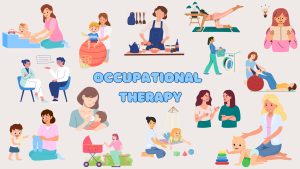1
What is Occupational Therapy?
Occupational therapy is a client-centered healthcare profession that focuses on enabling individuals to participate in daily activities and achieve independence in their lives. Through personalized interventions, occupational therapists assess and address the physical, emotional, and cognitive aspects of an individual’s well-being, facilitating improved function and quality of life.
Occupations refer to how we occupy our time. We do these occupations in various contexts and they are affected by our performance patterns, skills, and personal beliefs. Below are examples of areas of occupation, contexts, and factors that Occupational Therapy practitioners consider when treating an individual.

Occupations
Activities of Daily Living (ADLs), Instrumental Activities of Daily Living (IADLs), Health Management, Rest & Sleep, Education, Work, Play, Leisure, and Social Participation
Activities of Daily Living (ADLs)
- Bathing, showering: washing hair with shampoo
- Toileting, toilet hygiene: squatting on toilet and wiping after bowel movement
- Dressing: putting on pajamas
- Eating, swallowing: chewing breakfast
- Feeding: transferring food from plate to mouth
- Functional mobility: moving from chair to couch
- Personal hygiene, grooming: shaving, putting on deodorant, brushing teeth
- Sexual activity: kissing
Instrumental Activities of Daily Living (IADLs)
- Care of others: childcare, hiring a babysitter
- Care of pets and animals: providing for family dog
- Child rearing: nurturing child development
- Communication management: phones, call lights in a hospital setting
- Driving and community mobility: using your car, taking public bus
- Financial management: using a credit card, managing a checkbook
- Home establishment and management: watering flowers, tending the garden
- Meal preparation and cleanup: recipe planning, washing dishes
- Religious and spiritual expression: attending church
- Safety and emergency maintenance: emergency contact numbers
- Shopping: grocery list, online shopping
Health Management
- Social and emotional health promotion and maintenance: emotional regulation
- Symptom and condition management: pain management, coping
- Communication with the health care system: self-advocacy
- Medication management: taking medications at night
- Physical activity: running, swimming, lifting weights
- Nutrition management: eating a balanced diet, drinking water
- Personal care device management: wearing glasses, contraceptives
Rest and sleep
- Rest: quiet moment away from busy schedule
- Sleep preparation: turning on diffuser, playing relaxing music, meditation
- Sleep participation: napping
Education
- Formal education participation: taking anatomy exam
- Informal personal education needs or interests exploration: researching areas of interest
- Informal educational participation: completing online CEUs
Work
- Employment interests and pursuits: searching available job on LinkedIn
- Employment seeking and acquisition: viewing job application requirements, mock-interviews
- Job performance and maintenance: going to work and completing required tasks
- Retirement preparation and adjustment: finding new routine after employment
- Volunteer exploration: researching volunteer opportunities
- Volunteer participation: volunteering at animal shelter
Play
- Play exploration: selecting board game to play with friends
- Play participation: playing volleyball with team
Leisure
- Leisure exploration: recognize interests and skills
- Leisure participation: engage in book club with friends
Social participation
- Community participation: attend neighborhood block party
- Family participation: family dinners every Thursday night
- Friendships: fourth graders encouraging each other instead of bullying
- Intimate partner relationships: dating or platonic
- Peer group participation: classmate study night
Contexts
Environmental Factors and Personal Factors
Environmental factors
- Natural environment and human-made changes to the environment: geography, population, climate, natural events, human-caused events, light, time-related change, sound and vibration, air quality
- Products and technology: food and drugs
- , products and technology for individual use, indoor and outdoor mobility and transportation equipment, communication methods and modalities, education materials, employment facilities, recreational facilities, religious institutions, home-accessibility modifications, money
- Support and relationships: immediate and extended family, friends and coworkers, management team, health care staff, therapy dog
- Attitudes: mourning with friends, building rapport with patient, societal discrimination, societal norms
- Services, systems, and policies: Medicare and Medicaid, national government, employment policies
Personal factors
- Age: 45
- Sexual orientation: straight woman
- Gender identity: female
- Race and ethnicity: Black
- Cultural identification and cultural attitudes: traditional, family-oriented
- Social background, social status, and socioeconomic status: middle-class, husband is breadwinner
- Upbringing and life experiences: 2 siblings, raised in religious home with strong family dynamic, has 3 sons
- Habits and past and current behavioral patterns: yoga in am, walk in pm
- Individual psychological assets: introverted, anxious, selfless, creative
- Education: Master of Interior Design
- Professional and professional identity: Interior Designer, owns store
- Lifestyle: Business woman, works from home doing business side of store
- Other health conditions and fitness: Post-mastectomy from breast cancer, hysterectomy, Carpal Tunnel
Performance Patterns
Habits, Routines, Roles, and Rituals
- Habits: has to pee the second the key goes in the door upon arrival at home
- Routines: wake up, go to bathroom, wash face, drink coffee, get dressed
- Roles: mom, sibling, daughter, wife, businesswoman
- Rituals: prayer every night before bed
Performance Skills
Motor Skills, Process Skills, and Social Interaction Skills
- Motor skills: rests arm on counter when folding laundry due to back pain, difficulty gripping coffee mug due to Carpal Tunnel
- Process skills: asks physician multiple questions about taking care of a newborn after giving birth
- Social interaction skills: laughs and cries with other new moms at postpartum support group meeting
Client Factors
Values, Beliefs, Spirituality
Body Functions and Body Structures
- Values, beliefs, spirituality: loyalty to husband and family, committed to providing service to customers at Interior Design shop, Christian faith
- Body functions: some memory loss since giving birth, difficulty multi-tasking, emotional, low energy, hypertonic pelvic floor
- Body structures: digestive system function
Key Takeaways
- Women’s health is relevant across all occupations, contexts, performance patterns, skills, and client factors.
References:
-
American Occupational Therapy Association. (2020). Occupational therapy practice framework: Domain and process (4th ed.). American Journal of Occupational Therapy, 74(Suppl. 2), Article 7412410010. https://doi.org/10.5014/ajot.2020.74S2001
Media Attributions
- Canva Image 1
